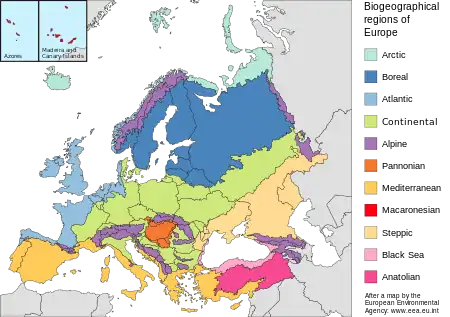Pannonian Biogeographic Region
The Pannonian Biogeographic Region is a biogeographic region, as defined by the European Environment Agency. It covers the lowlands of the Pannonian Basin centered on Hungary.
| Pannonian Biogeographic Region | |
|---|---|
 | |
 | |
| Ecology | |
| Realm | Palearctic |
| Geography | |
| Countries | Hungary, Slovakia, the Czech Republic, Romania, Serbia, Croatia, Ukraine |
| Rivers | Danube, Tisza |
Extent
The Pannonian Region is a large alluvial basin surrounded by the Carpathian Mountains to the north and east, the Alps to the west and the Dinaric Alps to the south. The basin was once the bed of an inland sea. It is flat, and is crossed from north to south by the Danube and Tisza rivers. The region contains all of Hungary, and around the periphery contains parts of Slovakia, the Czech Republic, Romania, Serbia, Croatia and Ukraine.[1]
Environment
The region is sheltered by the mountains, but has complex weather caused by the interaction of wet winds from the west, drier winds from the south and cooler winds from the Carpathians and Alps, which sometimes results in severe storms. The basin was once largely forested, with many marshes and shallow lakes, but has long been cleared and drained to make way for grasslands and cultivation. It contains inland sand dunes, sand steppes, loess grasslands and maple-oak loess forests.[2]
Sources
- Pannonian Biogeographical Region, European Commission, retrieved 2019-08-30
- Sundseth, Kerstin (2009), Natura 2000 in the Pannonian Region (PDF), European Commission Environment Directorate General, doi:10.2779/79432, ISBN 978-92-79-11586-8, retrieved 2019-08-30